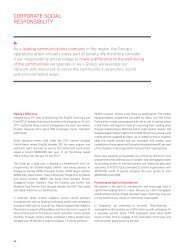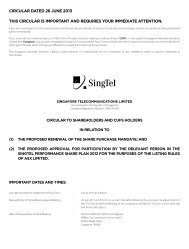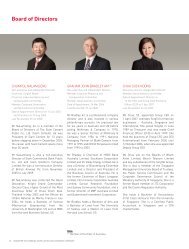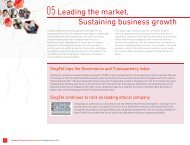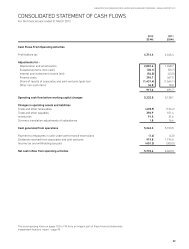Notes to the Financial Statements - SingTel
Notes to the Financial Statements - SingTel
Notes to the Financial Statements - SingTel
You also want an ePaper? Increase the reach of your titles
YUMPU automatically turns print PDFs into web optimized ePapers that Google loves.
<strong>Notes</strong> <strong>to</strong> <strong>the</strong> <strong>Financial</strong> <strong>Statements</strong>For <strong>the</strong> financial year ended 31 March 20112.29 Segment ReportingOperating segment is identified as <strong>the</strong> component of <strong>the</strong> Group that is regularly reviewed by <strong>the</strong> chief operating decision makerin order <strong>to</strong> allocate resources <strong>to</strong> <strong>the</strong> segment and <strong>to</strong> assess its performance.2.30 Non-current Assets (or Disposal Groups) Held for Sale and Discontinued OperationsNon-current assets (or disposal groups) are classified as assets held for sale and stated at <strong>the</strong> lower of carrying amount andfair value less costs <strong>to</strong> sell if <strong>the</strong>ir carrying amounts are recovered principally through sale transactions ra<strong>the</strong>r than throughcontinuing use.3. CRITICAL ACCOUNTING ESTIMATES AND JUDGEMENTSFRS 1, Presentation Of <strong>Financial</strong> <strong>Statements</strong>, requires disclosure of <strong>the</strong> judgements management has made in <strong>the</strong> process ofapplying <strong>the</strong> accounting policies that have <strong>the</strong> most impact on <strong>the</strong> amounts recognised in <strong>the</strong> financial statements. It alsorequires disclosure about <strong>the</strong> key assumptions concerning <strong>the</strong> future, and o<strong>the</strong>r key sources of estimation uncertainty at <strong>the</strong>end of <strong>the</strong> reporting period, that have a significant risk of causing a material adjustment <strong>to</strong> <strong>the</strong> carrying amounts of assets andliabilities within <strong>the</strong> next financial year. The estimates and assumptions are based on his<strong>to</strong>rical experience and o<strong>the</strong>r fac<strong>to</strong>rsthat are considered relevant. Actual results may differ from <strong>the</strong>se estimates.The following presents a summary of <strong>the</strong> critical accounting estimates and judgments -3.1 Impairment ReviewsThe accounting policies for impairment of non-financial assets are stated in Note 2.16.During an impairment review, <strong>the</strong> Group assesses whe<strong>the</strong>r <strong>the</strong> carrying amount of an asset or cash-generating unit exceeds itsrecoverable amount. Recoverable amount is defined as <strong>the</strong> higher of an asset’s or cash generating unit’s fair value less costs <strong>to</strong>sell and its value-in-use. In making this judgement, <strong>the</strong> Group evaluates <strong>the</strong> value-in-use which is supported by <strong>the</strong> net presentvalue of future cash flows derived from such assets using cash flow projections which have been discounted at an appropriaterate.Forecasts of future cash flows are based on <strong>the</strong> Group’s estimates using his<strong>to</strong>rical, sec<strong>to</strong>r and industry trends, general marketand economic conditions, changes in technology and o<strong>the</strong>r available information.The assumptions used by management <strong>to</strong> determine <strong>the</strong> value-in-use calculations of goodwill on acquisition of subsidiaries,and carrying values of associated and joint venture companies are stated in Note 23.3.2 Impairment of Trade ReceivablesThe Group assesses at <strong>the</strong> end of each reporting period whe<strong>the</strong>r <strong>the</strong>re is objective evidence that trade receivables have beenimpaired. Impairment loss is calculated based on a review of <strong>the</strong> current status of existing receivables and his<strong>to</strong>rical collectionsexperience. Such provisions are adjusted periodically <strong>to</strong> reflect <strong>the</strong> actual and anticipated experience.ANNUAL REPORT 2010/2011 117



